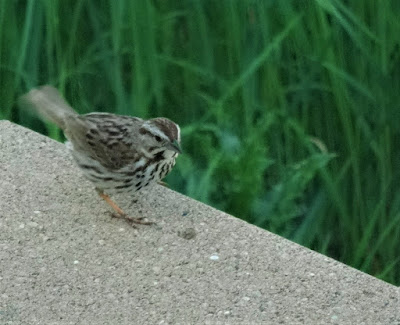8/10/2023
green heron
7/21/2023
empty nest
Cornell University has a program called NestWatch https://nestwatch.org/ where citizen scientists report on birds' nests they see. I missed this one until now; it was hidden very well in the reeds near the pond.
7/17/2023
fledgling robin
6/22/2023
two killdeers
6/17/2023
5/26/2023
song sparrow
Song Sparrow Melospiza melodia live up their binomial nomenclature 'melodia' by singing a delightful song, enthusiatically, and often.
They move along wetland edges like around the pond. I see the males occasionally, but they spend most of the time in dense, low vegetation.
5/22/2023
nest box Tree Swallows
Tree Swallows nest in cavities . . . old woodpecker holes in trees, or nest boxes. They do not go far south in winter; they return to Minnesota before any other swallows. They can eat plant foods, so they can survive before the insects come out. In the nest box near the pond, the Tree Swallow laid one egg each day in the last six days. She started incubating the eggs today. They will hatch in 11 to 20 days.
5/21/2023
4/28/2023
4/27/2023
yellow-rumped warbler
Yellow-rumped Warblers Setophaga coronata arrived here on the pond today on migration to the northern part of Minnesota and Canada, where they will nest and breed young birds. Also called "Myrtle" Warblers. On migration they eat fruits and seeds. Here, they flit along the shoreline hunting insects among the grasses. These individuals came to the feeders to eat thistle and sunflower chips. When more insects appear and the Warblers arrive on the breeding ground up north, they will eat caterpillars and other larvae, small beetles, weevils, ants, scale insects, aphids, grasshoppers, caddisflies, spiders, and gnats.
4/10/2023
tree swallows find nest box
We have boxes that Tree Swallows use to nest in. This bird was checking the box for suitability.
The box has a 'Sparrow Spooker' (nylon line attached securely with hook-eyes on top and around the entrance) that protects eggs and babies of Tree Swallows from House Sparrows who cannot negotiate the lines. House Sparrows destroy eggs and baby birds in other species' nests.
1/30/2023
tree sparrow
American Tree Sparrows come to the feeders often in winter. Spizelloides arborea Tree Sparrows often fluff out their feathers. A rusty cap makes them look like chipping sparrows, who migrate south of Minnesota for winter. These little birds come 'south' to the northern US for winter. In spring, they breed in the far north tundra in Canada (near the tree line) building nests on the ground, often in a tussock of grass. They sport a rusty eyeline, a brown back, and dark smudge in the center of the smooth breast.
1/16/2023
heavy snow
We use a metal toy 'slinky' to keep squirrels away from the bird feeders. The feeder was blown off the metal pole that held it. But the slinky held on and gathered a coating of the wet heavy snow.
Slinkys have been discouraging squirrels for many years in my experience as a bird watcher. They try to get to the feeders again and again. But they are startled by the movement under their claws, or their feet get tangled up in the flat wire coil.
12/30/2022
12/23/2022
sparrow
11/25/2022
11/04/2022
10/10/2022
hidden nest found in autumn
We trimmed back some undesirable willow plants around the pond. That action revealed a hidden nest. Earlier this summer, I found one Red-winged Blackbird nest near the pond in some reeds. All summer long, the male RWBB was bothered when anyone walked near the willows. He even dived at my head when I walked near that shore. I assumed he and his mate had a nest among the reeds closer to the pond. No wonder I could not find it in the reeds! It was revealed -- low in the willow sprouts -- when we trimmed around that area.




















